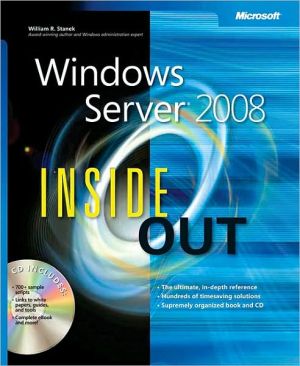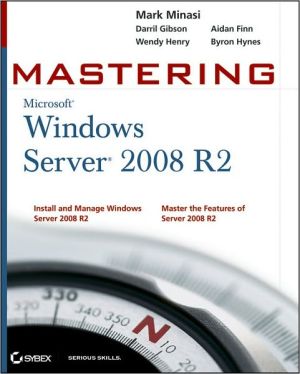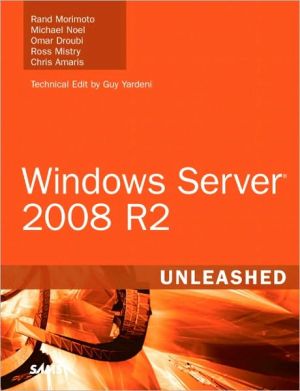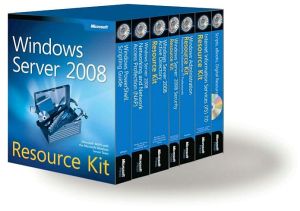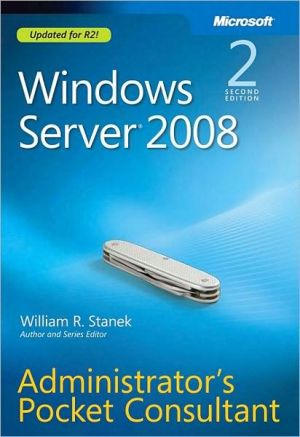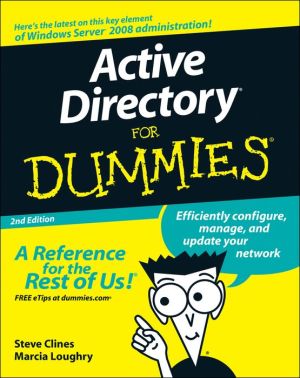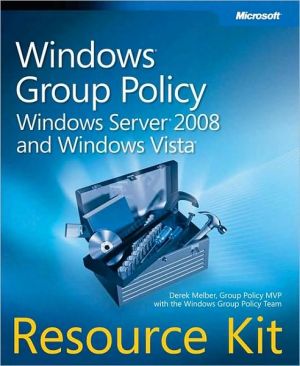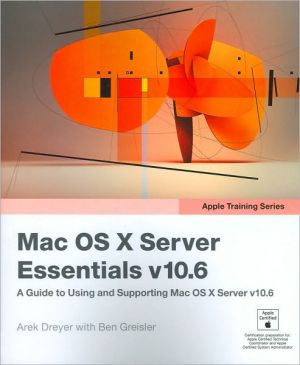Windows Server 2008 inside Out
Learn how to conquer Windows Server 2008—from the inside out! Designed for system administrators, this definitive resource features hundreds of timesaving solutions, expert insights, troubleshooting tips, and workarounds for administering Windows Server 2008—all in concise, fast-answer format. You will learn how to perform upgrades and migrations, automate deployments, implement security features, manage software updates and patches, administer users and accounts, manage Active Directory®...
Search in google:
Designed for system administrators, this handbook delivers timesaving solutions, tips and tools for deploying, managing, and troubleshooting Windows Server 2008, all in a fast-answers format. Includes a CD packed with more than 700 scripts, links to administration tools, reference guides, and more.
Acknowledgments; About the CD; What’s on the CD; System Requirements; Support Information; Conventions and Features Used in This Book; Text Conventions; Design Conventions; Part 1: Windows Server 2008 Overview and Planning; Chapter 1: Introducing Windows Server 2008; 1.1 What’s New in Windows Server 2008; 1.2 64-Bit Computing; 1.3 Virtualized Computing; 1.4 Windows Vista and Windows Server 2008; 1.5 Architecture Improvements; Chapter 2: Planning for Windows Server 2008; 2.1 Overview of Planning; 2.2 Identifying Your Organizational Teams; 2.3 Assessing Project Goals; 2.4 Analyzing the Existing Network; 2.5 Defining Objectives and Scope; 2.6 Defining the New Network Environment; 2.7 Selecting a Software Licensing Program; 2.8 Final Considerations for Planning and Deployment; Chapter 3: Installing Windows Server 2008; 3.1 Getting a Quick Start; 3.2 Preparing for Windows Server 2008 Installation; 3.3 Installing Windows Server 2008; 3.4 Performing Additional Administration Tasks During Installation; 3.5 Troubleshooting Installation; 3.6 Postinstallation; Part 2: Managing Windows Server 2008 Systems; Chapter 4: Managing Windows Server 2008; 4.1 Working with the Administration Tools; 4.2 Using the Initial Configuration Tasks Console; 4.3 Working with Computer Management; 4.4 Working with Server Manager; 4.5 Using Control Panel; 4.6 Using the System Console; Chapter 5: Configuring Windows Server 2008; 5.1 Optimizing the Menu System; 5.2 Customizing the Desktop and the Taskbar; 5.3 Optimizing Toolbars; Chapter 6: Windows Server 2008 MMC Administration; 6.1 Introducing the MMC; 6.2 Using the MMC; 6.3 Building Custom MMCs; 6.4 Designing Custom Taskpads for the MMC; 6.5 Publishing and Distributing Your Custom Tools; Chapter 7: Configuring Roles, Role Services, and Features; 7.1 Using Roles, Role Services, and Features; 7.2 Making Supplemental Components Available; 7.3 Installing Components with Server Manager; 7.4 Installing Components at the Command Line; Chapter 8: Managing and Troubleshooting Hardware; 8.1 Understanding Hardware Installation Changes; 8.2 Installing Devices; 8.3 Working with Device Drivers; 8.4 Managing Hardware; Chapter 9: Managing the Registry; 9.1 Introducing the Registry; 9.2 Understanding the Registry Structure; 9.3 Registry Root Keys; 9.4 Registry Data: How It Is Stored and Used; 9.5 Working with the Registry; 9.6 Backing Up and Restoring the Registry; 9.7 Maintaining the Registry; 9.8 Securing the Registry; Chapter 10: Software and User Account Control Administration; 10.1 Understanding Software Installation Changes; 10.2 Mastering User Account Control; 10.3 Maintaining Application Integrity; Chapter 11: Performance Monitoring and Tuning; 11.1 Tuning Performance, Memory Usage, and Data Throughput; 11.2 Tracking a System’s General Health; 11.3 Tracking Events and Troubleshooting by Using Event Viewer; Chapter 12: Comprehensive Performance Analysis and Logging; 12.1 Establishing Performance Baselines; 12.2 Monitoring Reliability and Performance; 12.3 Comprehensive Performance Monitoring; 12.4 Resolving Performance Bottlenecks; 12.5 Performance Logging; Part 3: Managing Windows Server 2008 Storage and File Systems; Chapter 13: Boot Configuration; 13.1 Boot from Hardware and Firmware; 13.2 Boot Environment Essentials; 13.3 Managing Startup and Boot Configuration; 13.4 Managing the Boot Configuration Data Store and Its Entries; Chapter 14: Storage Management; 14.1 Essential Storage Technologies; 14.2 Configuring Multipath I/O; 14.3 Installing and Configuring File Services; 14.4 Configuring Storage; 14.5 Managing MBR Disk Partitions on Basic Disks; 14.6 Managing GPT Disk Partitions on Basic Disks; 14.7 Managing Volumes on Dynamic Disks; Chapter 15: TPM and BitLocker Drive Encryption; 15.1 Working with Trusted Platforms; 15.2 Managing TPM; 15.3 Introducing BitLocker Drive Encryption; 15.4 Deploying BitLocker Drive Encryption; 15.5 Setting Up and Managing BitLocker Drive Encryption; Chapter 16: Managing Windows Server 2008 File Systems; 16.1 Understanding Disk and File System Structure; 16.2 Using FAT; 16.3 Using NTFS; 16.4 Advanced NTFS Features; 16.5 Using File-Based Compression; 16.6 Managing Disk Quotas; 16.7 Maintaining File System Integrity; 16.8 Defragmenting Disks; Chapter 17: File Sharing and Security; 17.1 File Sharing Essentials; 17.2 Creating and Publishing Shared Folders; 17.3 Managing Share Permissions; 17.4 Managing File and Folder Permissions; 17.5 Managing File Shares After Configuration; 17.6 Auditing File and Folder Access; Chapter 18: Using Volume Shadow Copy; 18.1 Shadow Copy Esssssssentials; 18.2 Managing Shadow Copies in Computer Management; 18.3 Configuring Shadow Copies at the Command Line; 18.4 Using Shadow Copies on Clients; Chapter 19: Using Remote Desktop for Administration; 19.1 Remote Desktop for Administration Essentials; 19.2 Configuring Remote Desktop for Administration; 19.3 Supporting Remote Desktop Connection Clients; 19.4 Tracking Who’s Logged On; Part 4: Managing Windows Server 2008 Networking and Print Services; Chapter 20: Networking with TCP/IP; 20.1 Navigating Networking in Windows Server 2008; 20.2 Using TCP/IP; 20.3 Understanding IPv4 Addressing; 20.4 Special IPv4 Addressing Rules; 20.5 Using Subnets and Subnet Masks; 20.6 Getting and Using IPv4 Addresses; 20.7 Understanding IPv6; 20.8 Understanding Name Resolution; Chapter 21: Managing TCP/IP Networking; 21.1 Installing TCP/IP Networking; 21.2 Configuring TCP/IP Networking; 21.3 Managing Network Connections; 21.4 Troubleshooting and Testing Network Settings; Chapter 22: Managing DHCP; 22.1 DHCP Essentials; 22.2 DHCP Security Considerations; 22.3 Planning DHCPv4 and DHCPv6 Implementations; 22.4 Setting Up DHCP Servers; 22.5 Configuring TCP/IP Options; 22.6 Advanced DHCP Configuration and Maintenance; 22.7 Setting Up DHCP Relay Agents; Chapter 23: Architecting DNS Infrastructure; 23.1 DNS Essentials; 23.2 Planning DNS Implementations; 23.3 Security Considerations; 23.4 Architecting a DNS Design; Chapter 24: Implementing and Managing DNS; 24.1 Installing the DNS Server Service; 24.2 Configuring DNS Using the Wizard; 24.3 Configuring DNS Zones, Subdomains, Forwarders, and Zone Transfers; 24.4 Adding Resource Records; 24.5 Deploying Global Names; 24.6 Maintaining and Monitoring DNS; 24.7 Troubleshooting the DNS Client Service; 24.8 Troubleshooting the DNS Server Service; Chapter 25: Implementing and Maintaining WINS; 25.1 WINS Essentials; 25.2 Setting Up WINS Servers; 25.3 Configuring Replication Partners; 25.4 Configuring and Maintaining WINS; 25.5 Enabling WINS Lookups Through DNS; Chapter 26: Deploying Print Services; 26.1 Understanding Windows Server 2008 Print Services; 26.2 Planning for Printer Deployments and Consolidation; 26.3 Setting Up Print Servers; 26.4 Managing Printers Throughout the Organization; Chapter 27: Managing and Maintaining Print Services; 27.1 Managing Printer Permissions; 27.2 Managing Print Server Properties; 27.3 Managing Printer Properties; 27.4 Managing Print Jobs; 27.5 Printer Maintenance and Troubleshooting; Chapter 28: Deploying Terminal Services; 28.1 Using Terminal Services; 28.2 Designing the Terminal Services Infrastructure; 28.3 Setting Up Terminal Services; 28.4 Using the Terminal Services Configuration Tool; 28.5 Configuring RemoteApps; 28.6 Using Terminal Services Manager; 28.7 Managing Terminal Services from the Command Line; 28.8 Other Useful Terminal Services Commands; 28.9 Configuring Terminal Services Per-User Settings; Part 5: Managing Active Directory and Security; Chapter 29: Active Directory Architecture; 29.1 Active Directory Physical Architecture; 29.2 Active Directory Logical Architecture; Chapter 30: Designing and Managing the Domain Environment; 30.1 Design Considerations for Active Directory Replication; 30.2 Design Considerations for Active Directory Search and Global Catalogs; 30.3 Design Considerations for Compatibility; 30.4 Design Considerations for Active Directory Authentication and Trusts; 30.5 Delegating Authentication; 30.6 Design Considerations for Active Directory Operations Masters; Chapter 31: Organizing Active Directory; 31.1 Creating an Active Directory Implementation or Update Plan; 31.2 Developing a Domain Plan; 31.3 Developing an Organizational Unit Plan; Chapter 32: Configuring Active Directory Sites and Replication; 32.1 Working with Active Directory Sites; 32.2 Understanding Active Directory Replication; 32.3 Replication Rings and Directory Partitions; 32.4 Developing or Revising a Site Design; Chapter 33: Implementing Active Directory Domain Services; 33.1 Preinstallation Considerations for Active Directory; 33.2 Installing Active Directory Domain Services; 33.3 Uninstalling Active Directory; 33.4 Creating and Managing Organizational Units (OUs); 33.5 Delegating Administration of Domains and OUs; Chapter 34: Deploying Read-Only Domain Controllers; 34.1 Introducing Read-Only Domain Controllers; 34.2 Design Considerations for Read-Only Replication; 34.3 Installing RODCs; 34.4 Managing Password Replication Policy; Chapter 35: Managing Users, Groups, and Computers; 35.1 Managing Domain User Accounts; 35.2 Managing User Profiles; 35.3 Managing User Data; 35.4 Maintaining User Accounts; 35.5 Managing Groups; 35.6 Managing Computer Accounts; Chapter 36: Managing Group Policy; 36.1 Understanding Group Policy; 36.2 Implementing Group Policy; 36.3 Managing Group Policy Through Delegation; 36.4 Managing Group Policy Inheritance and Processing; 36.5 Using Scripts in Group Policy; 36.6 Applying Group Policy Through Security Templates; 36.7 Maintaining and Troubleshooting Group Policy; Chapter 37: Active Directory Site Administration; 37.1 Managing Sites and Subnets; 37.2 Managing Site Links and Intersite Replication; 37.3 Monitoring and Troubleshooting Replication; Part 6: Windows Server 2008 Disaster Planning and Recovery; Chapter 38: Planning for High Availability; 38.1 Planning for Software Needs; 38.2 Planning for Hardware Needs; Chapter 39: Preparing and Deploying Server Clusters; 39.1 Introducing Server Clustering; 39.2 Using Network Load Balancing; 39.3 Managing Network Load Balancing Clusters; 39.4 Using Failover Clustering; 39.5 Running Failover Clusters; 39.6 Creating Failover Clusters; 39.7 Managing Failover Clusters and Their Resources; Chapter 40: Disaster Planning; 40.1 Preparing for a Disaster; 40.2 Disaster Preparedness Procedures; Chapter 41: Backup and Recovery; 41.1 Developing Backup Strategies; 41.2 Backing Up and Recovering Your Data; 41.3 Backing Up and Restoring Active Directory; 41.4 Troubleshooting Startup and Shutdown; Index to Troubleshooting Topics; About the Author; Additional Resources for IT Professionals from Microsoft Press; Windows Server; Windows Client; SQL Server 2005; Exchange Server 2007; Scripting; More Great Resources for IT Professionals from Microsoft Press; Administrator’s Pocket Consultant; Administrator’s Companion; Resource Kit; Self-Paced Training Kit;
